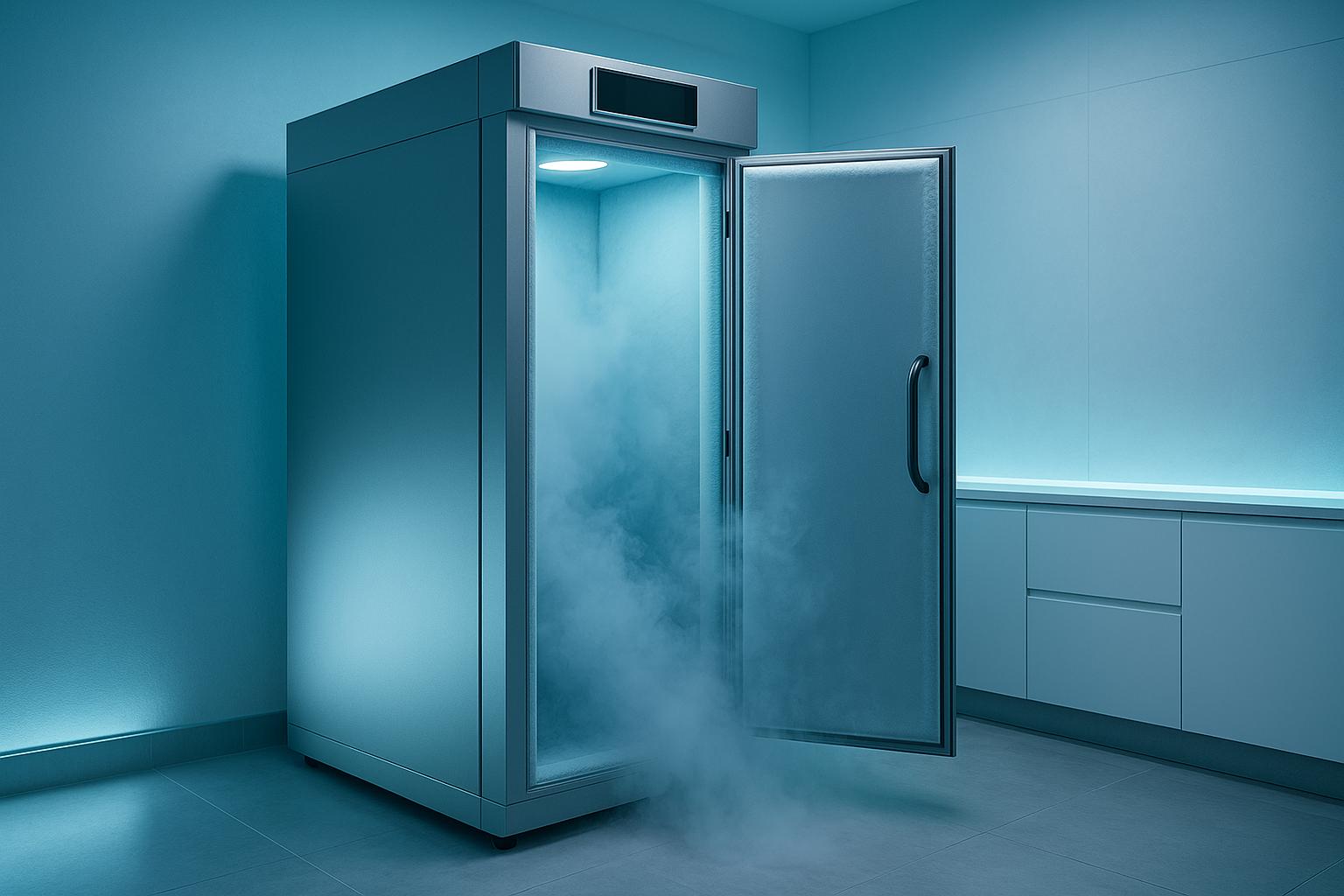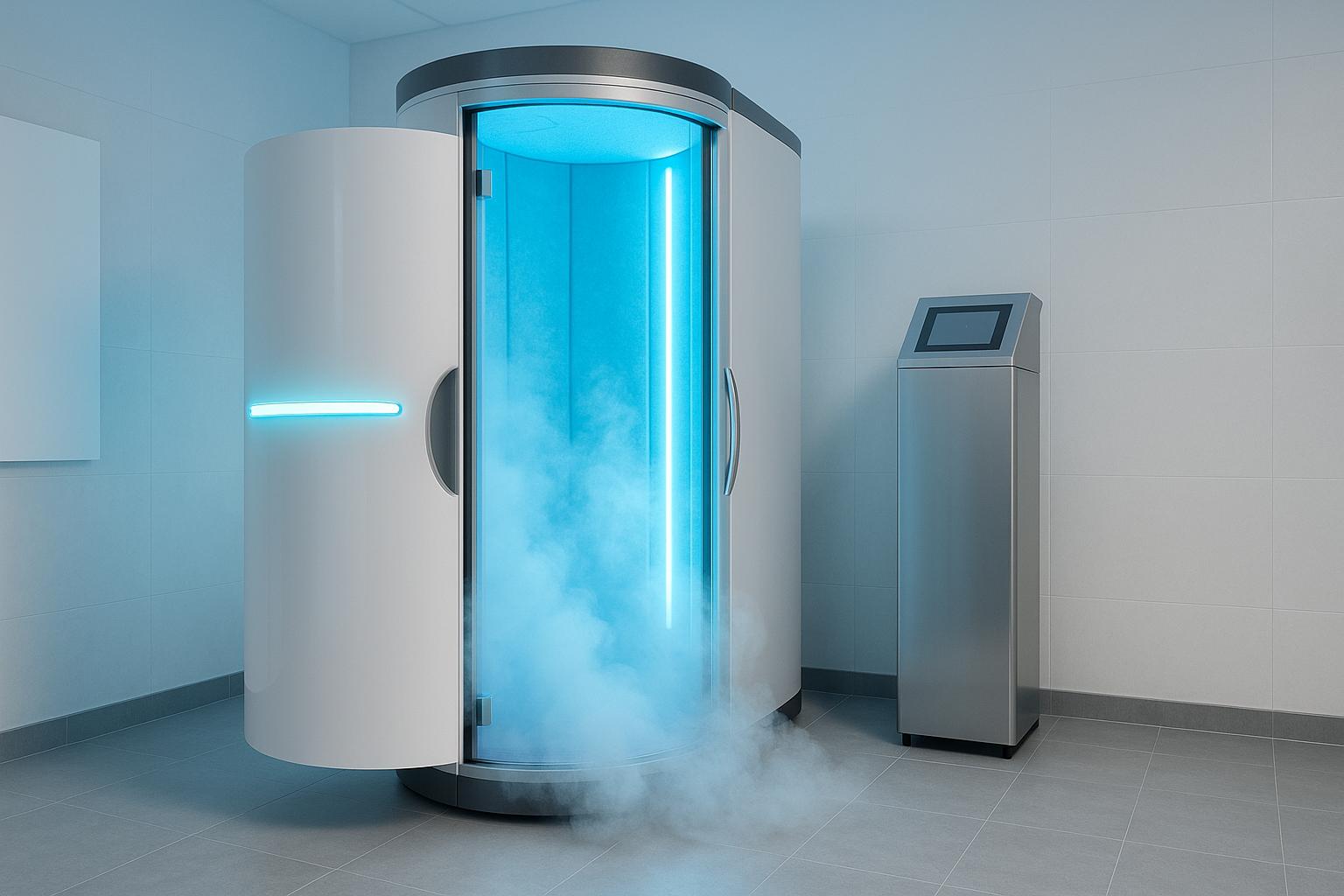Cryotherapy and ice baths are both effective cold therapy methods for recovery, but they work differently. Cryotherapy is fast, using ultra-cold air (-85°C in our state of the art whole body chamber) for 3–5 minutes, ideal for quick inflammation relief and acute injuries. Ice baths involve 10–20 minutes of immersion in cold water (10°C to 15°C), offering deeper, longer-lasting cooling for muscle fatigue and chronic recovery.
Key Differences:
- Cryotherapy: Short sessions, rapid cooling, costs £25-50/session.
- Ice Bath: Longer sessions, gradual cooling, low-cost or equipment-based.
Quick Comparison:
| Aspect | Whole Body Cryotherapy | Ice Bath |
|---|---|---|
| Temperature | -85°C | 10°C to 15°C |
| Duration | 3–5 minutes | 10–20 minutes |
| Best For | Acute injuries, quick recovery | Chronic issues, deep tissue recovery |
| Cost | £25-50 per session | Low-cost, equipment-based |
| Safety | Controlled environment | Requires monitoring |
Choose cryotherapy for speed and precision or ice baths for affordability and sustained cooling. Always consult a medical professional before starting cold therapy.
Ice Bath Vs. Cryotherapy
The Science Behind Cold Therapy
When exposed to extreme cold, the hypothalamus kicks in to activate the body’s defense mechanisms, ensuring core temperature stays stable.
Cryotherapy Treatment Process
Whole-body cryotherapy involves exposing the body to ultra-cold air (-85°C), for a brief 3-5 minutes. This triggers rapid vasoconstriction, which reduces blood flow to surface tissues.
Ice Bath Treatment Process
Ice bath therapy requires immersing the body in water cooled to 10°C to 15°C for 10–20 minutes. This approach cools the body gradually, leading to a longer-lasting reduction in temperature in the targeted areas.
| Treatment Aspect | Cryotherapy | Ice Bath |
|---|---|---|
| Temperature | -85°C | 10°C to 15°C |
| Duration | 3-5 minutes | 10–20 minutes |
| Tissue Temperature | 19.0±0.9°C | 20.5±0.6°C |
| Cooling Method | Dry air | Water immersion |
| Temperature Drop | Rapid | Gradual |
Both approaches aim to reduce inflammation and aid recovery by causing vasoconstriction. However, their differences in temperature, duration, and cooling methods lead to unique effects on the body. These distinctions pave the way for evaluating recovery benefits, safety, and cost in the upcoming section.
Direct Comparison: Cryotherapy vs Ice Baths
Recovery Results
Cryotherapy and ice baths work differently when it comes to recovery. Cryotherapy delivers an intense cooling effect almost instantly, while ice baths keep tissue temperatures lower for a longer period. This makes cryotherapy ideal for quick recovery, whereas ice baths are better for extended relief.
Cryotherapy’s extreme cold sparks a fast anti-inflammatory response, which is particularly helpful for acute injuries. On the other hand, the slower cooling of ice baths is better suited for chronic issues and recovery after competitions.
These differences also bring up important safety considerations.
Safety and Risk Factors
Cryotherapy chambers are carefully controlled, minimizing risks like frostbite or hypothermia when used under professional supervision. Ice baths, however, can be less predictable, with a greater risk of hypothermia if not properly monitored.
| Safety Aspect | Cryotherapy | Ice Bath |
|---|---|---|
| Environment Control | Controlled dry air environment | Variable water conditions |
| Risk Factors | Lower risk of frostbite/hypothermia | Higher risk without supervision |
| Supervision | Professional supervision required | Supervision is recommended |
Time and Money Comparison
Cost and time are also key factors to weigh. Cryotherapy sessions are short, lasting just 2-4 minutes, but they come at a higher price – typically £25-50 per session. This makes them a great choice for athletes who need quick recovery and have tight schedules.
Ice baths, while more time-consuming (10-20 minutes per session), are a budget-friendly option. Many gyms include ice bath access in memberships, and buying your own setup for home use is a one-time expense that allows unlimited sessions.
For athletes needing fast recovery between same-day events, cryotherapy might be the better option. Meanwhile, those focusing on long-term recovery could find ice baths more practical and economical.
sbb-itb-32603e3
Selecting Your Cold Therapy Method
Matching Methods to Recovery Needs
Pick the cold therapy method that aligns with your recovery goals. Cryotherapy offers quick relief from inflammation and pain through short sessions, while ice baths provide longer-lasting cooling, ideal for deeper tissue recovery.
Here’s a quick breakdown:
| Recovery Need | Recommended Method | Why It Works Best |
|---|---|---|
| Acute injury recovery | Cryotherapy | Fast inflammation relief and pain management |
| Post-competition recovery | Ice bath | Long-lasting cooling for overall muscle fatigue |
| Same-day event preparation | Cryotherapy | Quick results without disrupting your schedule |
| Chronic condition management | Ice bath | Consistent therapeutic benefits and cost-efficient |
Your choice might also depend on practical concerns like availability and cost. For instance, professional athletes often have access to cryotherapy facilities, while ice baths are a more budget-friendly option for many.
Before committing to a method, consult a medical professional to ensure it suits your health profile.
Medical Guidance Requirements
It’s crucial to seek medical advice before starting cold therapy, especially if you have:
- Heart conditions: Cold exposure can impact blood pressure and heart rate.
- Circulatory problems: Extreme temperature changes may trigger negative reactions.
- Recent injuries: Timing and method selection are key for proper healing.
Dr. Sarah Thompson, a sports medicine specialist at the Olympic Training Center, notes: "The effectiveness of cold therapy varies significantly based on individual physiology and specific recovery needs. What works for elite athletes may not be suitable for recreational sports enthusiasts."
Follow these steps for safe and effective use:
- Initial Assessment: Get medical clearance if you have any pre-existing conditions.
- Start Slowly: Begin with shorter exposure times and moderate temperatures.
- Monitor Progress: Pay attention to how your body reacts and adjust as needed.
Cryotherapy sessions usually include professional oversight, while ice baths require careful self-monitoring of water temperature and exposure time, especially in home or gym setups.
Comparing Cryotherapy and Ice Baths
Cryotherapy and ice baths are both effective recovery tools, but each works best in specific situations. Cryotherapy uses ultra-cold air for fast pain relief and inflammation reduction, making it ideal for quick recovery after intense physical activity. On the other hand, ice baths involve immersing the body in cold water for a longer period, which targets deep tissue recovery and helps flush out metabolic waste as blood flow improves during the rebound phase.
Here’s a quick comparison of the two methods:
| Recovery Method | Best For | Typical Results | Cost |
|---|---|---|---|
| Cryotherapy | Quick recovery and acute inflammation | Immediate pain relief and reduced swelling | $55–75 per session |
| Ice Bath | Regular training recovery and deep cooling | Longer-lasting cooling and waste removal | Low-cost, equipment-based |
When to Choose Cryotherapy
Cryotherapy is an excellent option if you need fast results or are dealing with acute injuries. It’s especially useful for:
- Professional athletes needing quick recovery between events
- Those with injuries requiring precise temperature control
- Individuals with limited time for recovery sessions
When to Opt for Ice Baths
Ice baths are better suited for routine recovery and are easier on the wallet. They’re a great fit for:
- Athletes with regular training schedules
- Budget-conscious fitness enthusiasts
- Those looking for a deeper cooling effect on tissues
Finding the Right Balance
The best recovery method depends on your needs, schedule, and budget. Some people even combine cryotherapy for immediate relief with ice baths for longer-lasting benefits. Since everyone’s body responds differently, consulting a healthcare professional can help you create a recovery plan that works for you.
FAQs
Here’s a breakdown of common questions and comparisons to help you understand the differences:
Is an ice bath as effective as cryotherapy?
Both methods support recovery but work in different ways. Ice baths provide a slower cooling process over 10–20 minutes, while cryotherapy involves a quick 3-5 minute session with tightly controlled temperatures. Research suggests cryotherapy can reduce inflammation more quickly, offering faster relief.
Is an ice bath better than cryotherapy?
It depends on your needs. Ice baths are a longer, more affordable option, while cryotherapy offers a fast, highly controlled cooling experience. Cryotherapy sessions are ultra-cold and brief, which can be more convenient. Your choice should align with your recovery goals, budget, and tolerance for cold.
Are cryo chambers better than ice baths?
Here’s a quick comparison to help you decide:
| Feature | Cryo Chamber | Ice Bath |
|---|---|---|
| Session Duration | 3-5 minutes | 10–20 minutes |
| Temperature Control | Precise (–85°C) | Variable (10°C to 15°C) |
| Risk Management | Lower hypothermia risk | Requires monitoring |
| Cost per Session | £25-50 | Lower (equipment-based) |
Cryo chambers offer a safer, more controlled environment, reducing the risk of hypothermia and discomfort for those sensitive to cold. That said, their higher cost might make ice baths a better option for frequent use or those on a budget.







